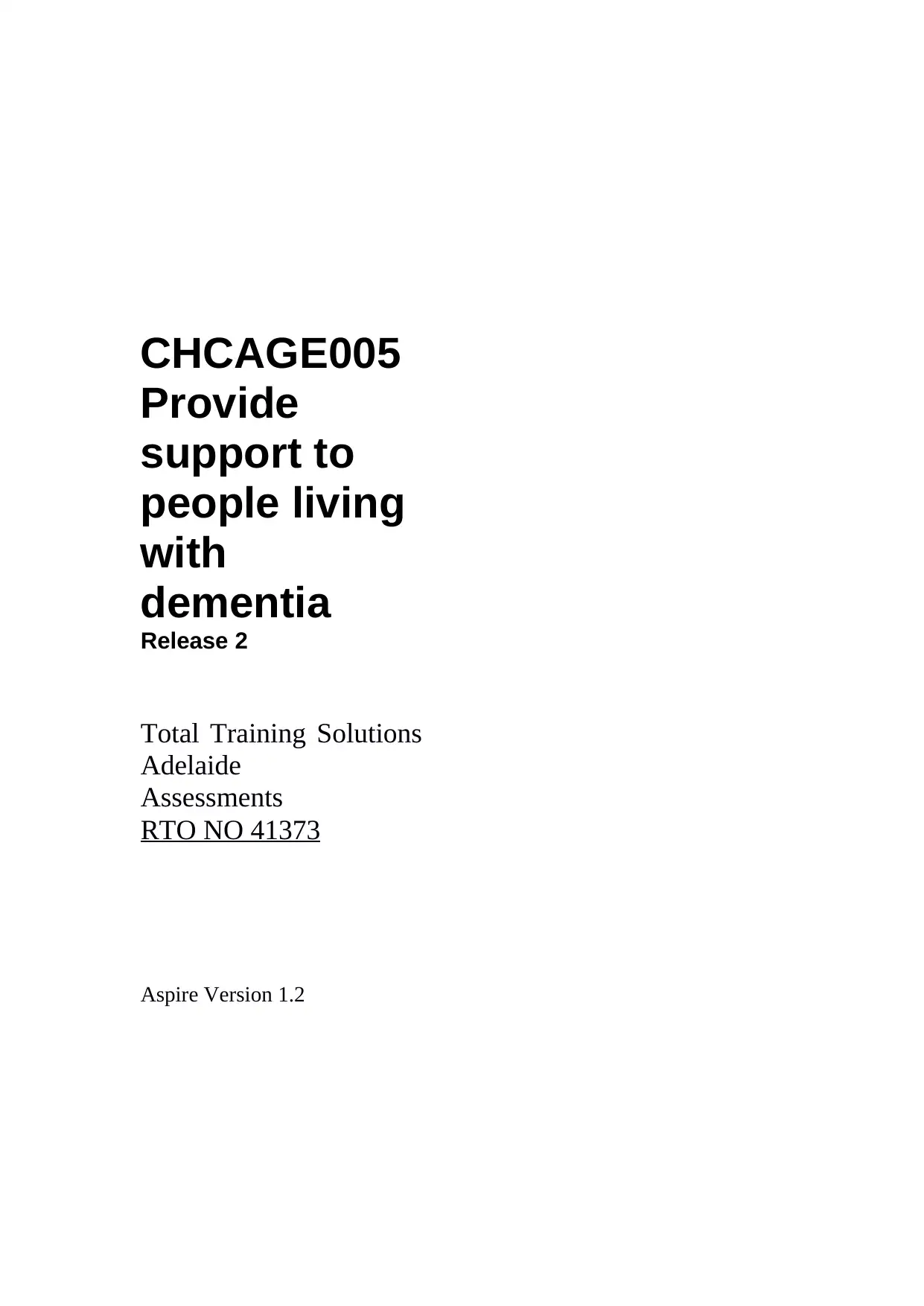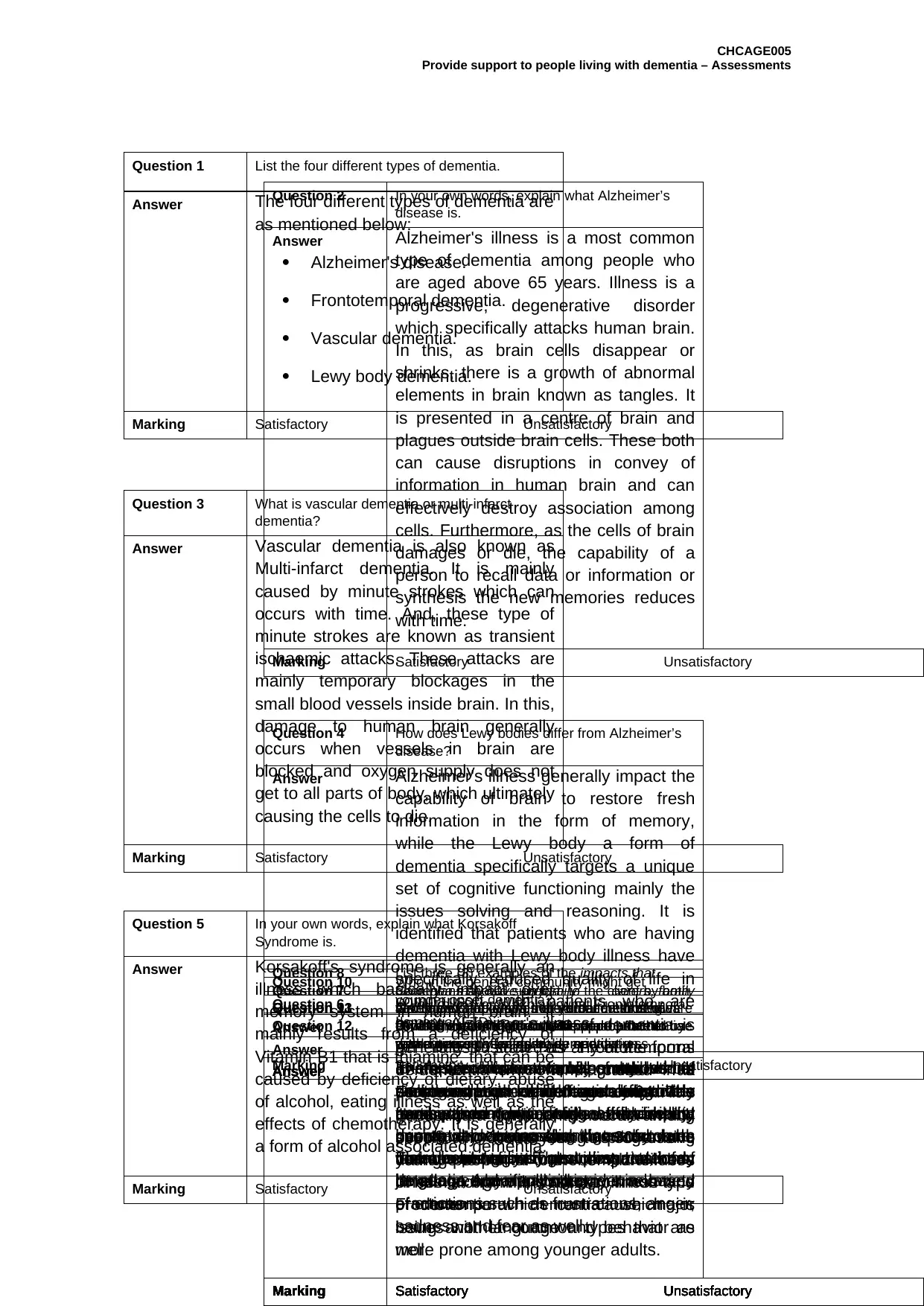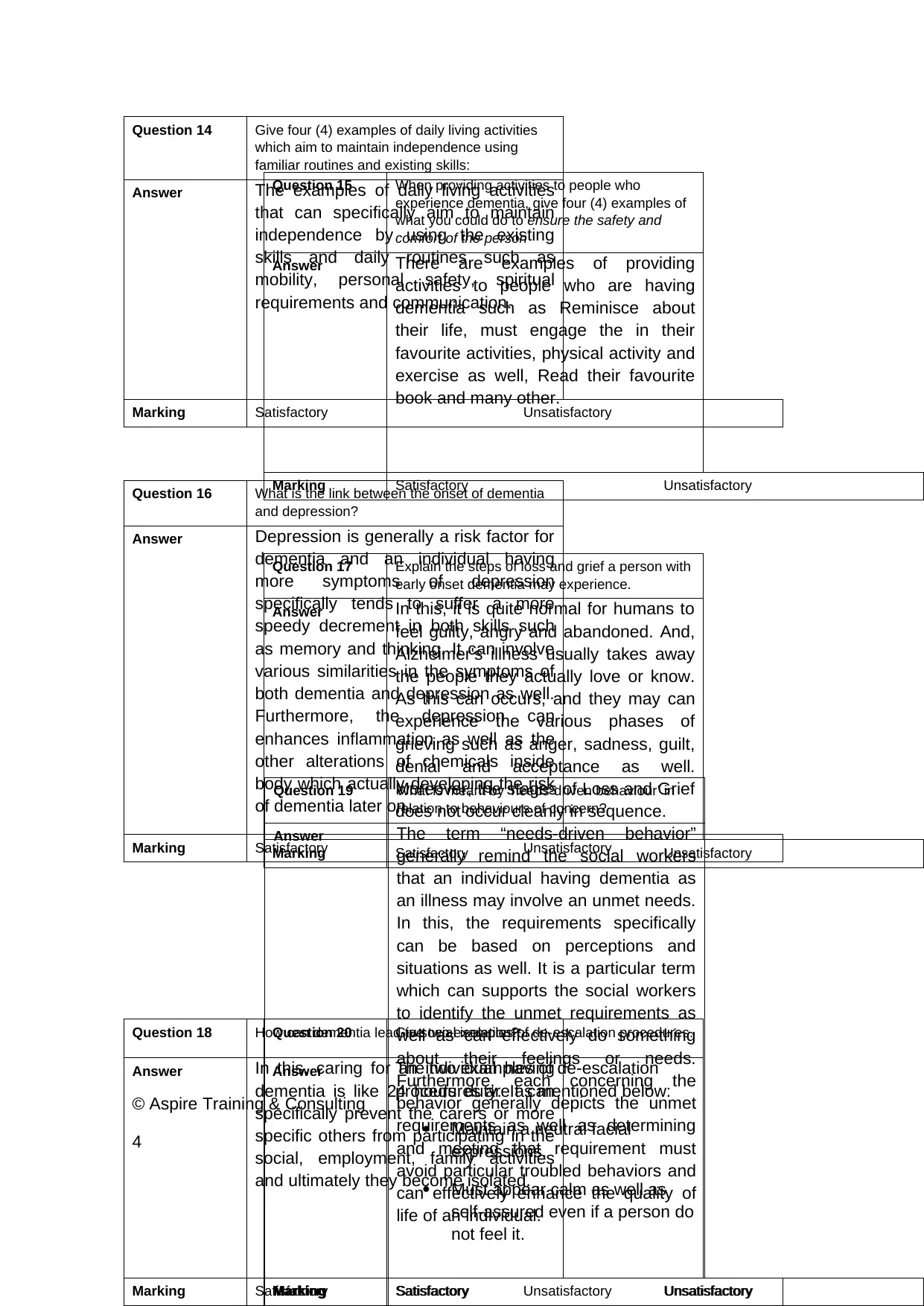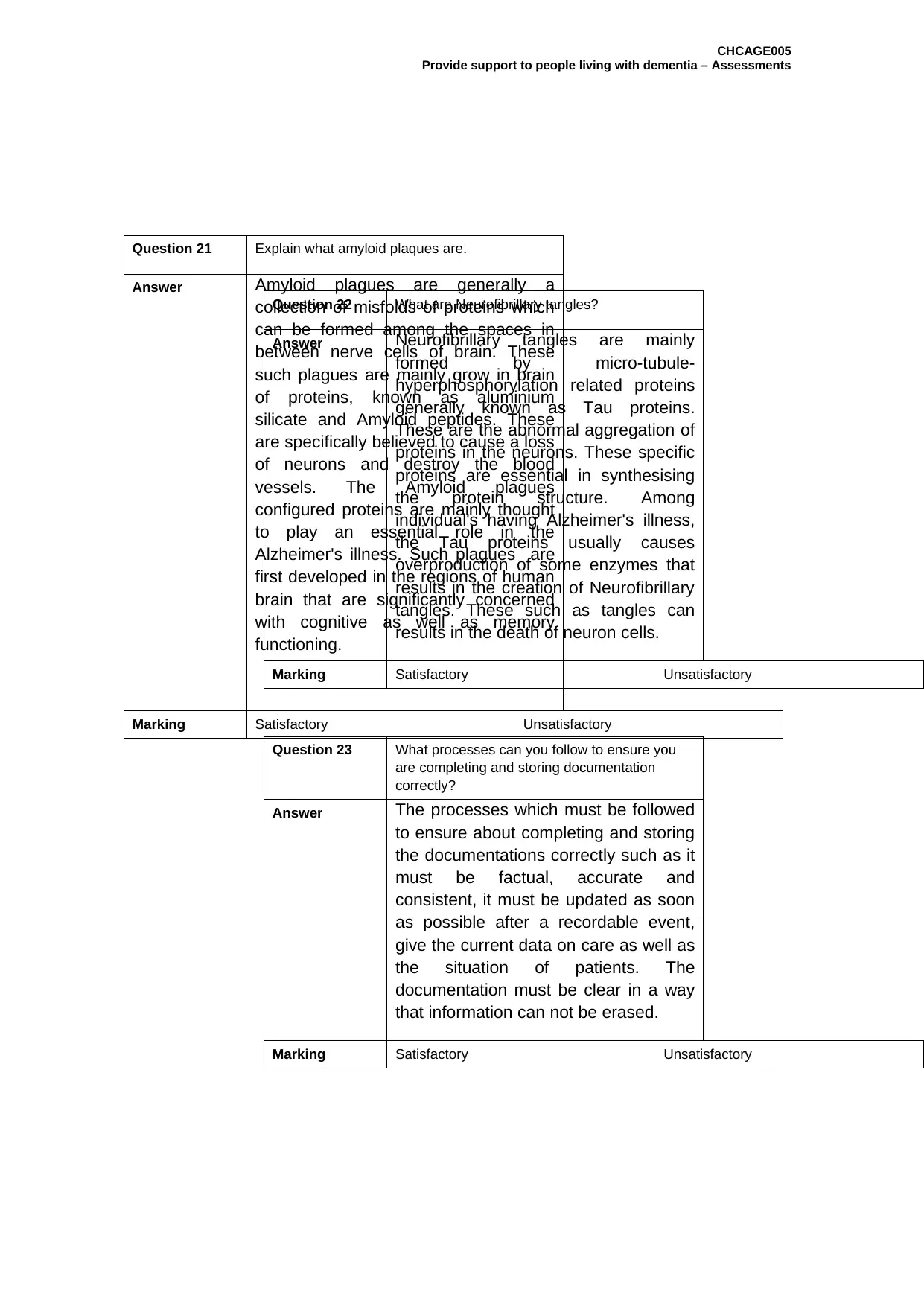CHCAGE005: Support for People with Dementia - Comprehensive Guide
VerifiedAdded on 2023/06/14
|5
|1782
|190
Homework Assignment
AI Summary
This CHCAGE005 assignment solution comprehensively addresses various aspects of providing support to individuals living with dementia. It defines different types of dementia, including Alzheimer's disease, frontotemporal dementia, vascular dementia, and Lewy body dementia, detailing their specific impacts on cognitive functions and behavior. The solution discusses effective communication strategies, such as validation therapy and non-verbal cues, to manage agitation and distress in dementia patients. It emphasizes the importance of maintaining independence through familiar routines and daily living activities, while also addressing safety and comfort. Furthermore, the assignment explores the link between dementia and depression, the grieving process experienced by individuals with dementia, and the concept of 'needs-driven behavior'. It also provides examples of de-escalation procedures and discusses the significance of accurate documentation. Key pathological features like amyloid plaques and neurofibrillary tangles are explained in the context of Alzheimer's disease. This assignment solution is available on Desklib, where students can access a wealth of study resources and solved assignments.

CHCAGE005
Provide
support to
people living
with
dementia
Release 2
Total Training Solutions
Adelaide
Assessments
RTO NO 41373
Aspire Version 1.2
Provide
support to
people living
with
dementia
Release 2
Total Training Solutions
Adelaide
Assessments
RTO NO 41373
Aspire Version 1.2
Paraphrase This Document
Need a fresh take? Get an instant paraphrase of this document with our AI Paraphraser

Header
© Aspire Training & Consulting
2
© Aspire Training & Consulting
2

CHCAGE005
Provide support to people living with dementia – Assessments
Question 1 List the four different types of dementia.
Answer The four different types of dementia are
as mentioned below:
Alzheimer's disease.
Frontotemporal dementia.
Vascular dementia.
Lewy body dementia.
Marking Satisfactory Unsatisfactory
Question 2 In your own words, explain what Alzheimer’s
disease is.
Answer Alzheimer's illness is a most common
type of dementia among people who
are aged above 65 years. Illness is a
progressive, degenerative disorder
which specifically attacks human brain.
In this, as brain cells disappear or
shrinks, there is a growth of abnormal
elements in brain known as tangles. It
is presented in a centre of brain and
plagues outside brain cells. These both
can cause disruptions in convey of
information in human brain and can
effectively destroy association among
cells. Furthermore, as the cells of brain
damages or die, the capability of a
person to recall data or information or
synthesis the new memories reduces
with time.
Marking Satisfactory Unsatisfactory
Question 3 What is vascular dementia or multi-infarct
dementia?
Answer Vascular dementia is also known as
Multi-infarct dementia. It is mainly
caused by minute strokes which can
occurs with time. And, these type of
minute strokes are known as transient
ischaemic attacks. These attacks are
mainly temporary blockages in the
small blood vessels inside brain. In this,
damage to human brain generally
occurs when vessels in brain are
blocked and oxygen supply does not
get to all parts of body, which ultimately
causing the cells to die.
Marking Satisfactory Unsatisfactory
Question 4 How does Lewy bodies differ from Alzheimer’s
disease?
Answer Alzheimer's illness generally impact the
capability of brain to restore fresh
information in the form of memory,
while the Lewy body a form of
dementia specifically targets a unique
set of cognitive functioning mainly the
issues solving and reasoning. It is
identified that patients who are having
dementia with Lewy body illness have
specifically reduced quality of life in
comparison with patients who are
having Alzheimer's illness.
Marking Satisfactory Unsatisfactory
Question 5 In your own words, explain what Korsakoff
Syndrome is.
Answer Korsakoff's syndrome is generally an
illness which basically impact over
memory system in human brain. It
mainly results from a deficiency of
Vitamin B1 that is thiamine, that can be
caused by deficiency of dietary, abuse
of alcohol, eating illness as well as the
effects of chemotherapy. It is generally
a form of alcohol associated dementia.
Marking Satisfactory Unsatisfactory
Question 6 In your own words explain what Frontotemporal
dementia (FTD) is.
Answer An illness such as Frontotemporal
dementia is often called as
Frontotemporal lobar degeneration. It s
generally a form of dementia which
specifically occurs due to progressive
damage to frontal or the temporal lobes
of human brain. It is not a common type
of dementia which can cause major
issues with language and behavior as
well.
Marking Satisfactory Unsatisfactory
Question 7 Care plans should suggest to the client by both
family and staff, using recommendations from
both family and staff. List 2 approaches that
would generally be used
Answer In this, collaborative approaches to
well-being generally containing the
participation of families which is
important in giving client centred care.
The consistency in providing care can
be attained by applying evidence based
practices.
Marking Satisfactory Unsatisfactory
Question 8 List three (3) examples of the impacts that
dementia may have on family carers, family
and significant others that you need to be aware
of when supporting people who are affected by
dementia
Answer In this, when a family member is
diagnosed with dementia or any other
forms of dementia, it generally impact
over whole family that can be
overwhelming. The impacts of
dementia specifically triggers a variety
of emotions such as frustrations, anger,
sadness and fear as well.
Marking Satisfactory Unsatisfactory
Question 9 Give an example of a non-verbal method of
communication that would be appropriate to use
with a person affected by dementia:
Answer The examples of non-verbal
communication which can be used as
an appropriate way with an individual
having dementia as an illness such as
facial expressions, gestures and body
language.
Marking Satisfactory Unsatisfactory
Question 10 Who in the general community might get
younger onset dementia?
Answer In this, younger onset of dementia is
generally illustrated as any of the forms
of dementia which is diagnosed in a
person who are under age of 64. The
illness can significantly occur among
people who are as young as 30. among
young people, it can be Alzheimer's
illness along with vascular illness and
Frontotemporal dementia which is
being another common types that are
more prone among younger adults.
Marking Satisfactory Unsatisfactory
Question 11 Give an example of a non-verbal method of
communication that would be appropriate to use
with a person affected by dementia
Answer Examples of non-verbal methods of
communication which are effectively
used among people affected by
dementia are such as touch,
movements of body and postures, body
language and many other.
Marking Satisfactory Unsatisfactory
Question 12 Give an example of how you would provide
reassurance by using reality orientation
Answer There are two examples by which
social workers can effectively provide
reassurance by using the reality
orientation. It can be done by both
verbal and non-verbal communications.
Marking Satisfactory Unsatisfactory
Question 13 List three (3) examples of validation strategies
you could use if a person affected by dementia
is showing signs of agitation and distress
Answer There are three examples of validation
strategies provided in the module that
can be used if an individual affected by
dementia by expressing signs of
distress and agitation such as Lost of
jewellery, A man outside my window.
Marking Satisfactory Unsatisfactory
Provide support to people living with dementia – Assessments
Question 1 List the four different types of dementia.
Answer The four different types of dementia are
as mentioned below:
Alzheimer's disease.
Frontotemporal dementia.
Vascular dementia.
Lewy body dementia.
Marking Satisfactory Unsatisfactory
Question 2 In your own words, explain what Alzheimer’s
disease is.
Answer Alzheimer's illness is a most common
type of dementia among people who
are aged above 65 years. Illness is a
progressive, degenerative disorder
which specifically attacks human brain.
In this, as brain cells disappear or
shrinks, there is a growth of abnormal
elements in brain known as tangles. It
is presented in a centre of brain and
plagues outside brain cells. These both
can cause disruptions in convey of
information in human brain and can
effectively destroy association among
cells. Furthermore, as the cells of brain
damages or die, the capability of a
person to recall data or information or
synthesis the new memories reduces
with time.
Marking Satisfactory Unsatisfactory
Question 3 What is vascular dementia or multi-infarct
dementia?
Answer Vascular dementia is also known as
Multi-infarct dementia. It is mainly
caused by minute strokes which can
occurs with time. And, these type of
minute strokes are known as transient
ischaemic attacks. These attacks are
mainly temporary blockages in the
small blood vessels inside brain. In this,
damage to human brain generally
occurs when vessels in brain are
blocked and oxygen supply does not
get to all parts of body, which ultimately
causing the cells to die.
Marking Satisfactory Unsatisfactory
Question 4 How does Lewy bodies differ from Alzheimer’s
disease?
Answer Alzheimer's illness generally impact the
capability of brain to restore fresh
information in the form of memory,
while the Lewy body a form of
dementia specifically targets a unique
set of cognitive functioning mainly the
issues solving and reasoning. It is
identified that patients who are having
dementia with Lewy body illness have
specifically reduced quality of life in
comparison with patients who are
having Alzheimer's illness.
Marking Satisfactory Unsatisfactory
Question 5 In your own words, explain what Korsakoff
Syndrome is.
Answer Korsakoff's syndrome is generally an
illness which basically impact over
memory system in human brain. It
mainly results from a deficiency of
Vitamin B1 that is thiamine, that can be
caused by deficiency of dietary, abuse
of alcohol, eating illness as well as the
effects of chemotherapy. It is generally
a form of alcohol associated dementia.
Marking Satisfactory Unsatisfactory
Question 6 In your own words explain what Frontotemporal
dementia (FTD) is.
Answer An illness such as Frontotemporal
dementia is often called as
Frontotemporal lobar degeneration. It s
generally a form of dementia which
specifically occurs due to progressive
damage to frontal or the temporal lobes
of human brain. It is not a common type
of dementia which can cause major
issues with language and behavior as
well.
Marking Satisfactory Unsatisfactory
Question 7 Care plans should suggest to the client by both
family and staff, using recommendations from
both family and staff. List 2 approaches that
would generally be used
Answer In this, collaborative approaches to
well-being generally containing the
participation of families which is
important in giving client centred care.
The consistency in providing care can
be attained by applying evidence based
practices.
Marking Satisfactory Unsatisfactory
Question 8 List three (3) examples of the impacts that
dementia may have on family carers, family
and significant others that you need to be aware
of when supporting people who are affected by
dementia
Answer In this, when a family member is
diagnosed with dementia or any other
forms of dementia, it generally impact
over whole family that can be
overwhelming. The impacts of
dementia specifically triggers a variety
of emotions such as frustrations, anger,
sadness and fear as well.
Marking Satisfactory Unsatisfactory
Question 9 Give an example of a non-verbal method of
communication that would be appropriate to use
with a person affected by dementia:
Answer The examples of non-verbal
communication which can be used as
an appropriate way with an individual
having dementia as an illness such as
facial expressions, gestures and body
language.
Marking Satisfactory Unsatisfactory
Question 10 Who in the general community might get
younger onset dementia?
Answer In this, younger onset of dementia is
generally illustrated as any of the forms
of dementia which is diagnosed in a
person who are under age of 64. The
illness can significantly occur among
people who are as young as 30. among
young people, it can be Alzheimer's
illness along with vascular illness and
Frontotemporal dementia which is
being another common types that are
more prone among younger adults.
Marking Satisfactory Unsatisfactory
Question 11 Give an example of a non-verbal method of
communication that would be appropriate to use
with a person affected by dementia
Answer Examples of non-verbal methods of
communication which are effectively
used among people affected by
dementia are such as touch,
movements of body and postures, body
language and many other.
Marking Satisfactory Unsatisfactory
Question 12 Give an example of how you would provide
reassurance by using reality orientation
Answer There are two examples by which
social workers can effectively provide
reassurance by using the reality
orientation. It can be done by both
verbal and non-verbal communications.
Marking Satisfactory Unsatisfactory
Question 13 List three (3) examples of validation strategies
you could use if a person affected by dementia
is showing signs of agitation and distress
Answer There are three examples of validation
strategies provided in the module that
can be used if an individual affected by
dementia by expressing signs of
distress and agitation such as Lost of
jewellery, A man outside my window.
Marking Satisfactory Unsatisfactory
⊘ This is a preview!⊘
Do you want full access?
Subscribe today to unlock all pages.

Trusted by 1+ million students worldwide

© Aspire Training & Consulting
4
Question 14 Give four (4) examples of daily living activities
which aim to maintain independence using
familiar routines and existing skills:
Answer The examples of daily living activities
that can specifically aim to maintain
independence by using the existing
skills and daily routines such as
mobility, personal safety, spiritual
requirements and communication.
Marking Satisfactory Unsatisfactory
Question 15 When providing activities to people who
experience dementia, give four (4) examples of
what you could do to ensure the safety and
comfort of the person
Answer There are examples of providing
activities to people who are having
dementia such as Reminisce about
their life, must engage the in their
favourite activities, physical activity and
exercise as well, Read their favourite
book and many other.
Marking Satisfactory Unsatisfactory
Question 16 What is the link between the onset of dementia
and depression?
Answer Depression is generally a risk factor for
dementia and an individual having
more symptoms of depression
specifically tends to suffer a more
speedy decrement in both skills such
as memory and thinking. It can involve
various similarities in the symptoms of
both dementia and depression as well.
Furthermore, the depression can
enhances inflammation as well as the
other alterations of chemicals inside
body which actually developing the risk
of dementia later on.
Marking Satisfactory Unsatisfactory
Question 17 Explain the steps of loss and grief a person with
early onset dementia may experience.
Answer In this, it is quite normal for humans to
feel guilty, angry and abandoned. And,
Alzheimer's illness usually takes away
the people they actually love or know.
As this can occurs, and they may can
experience the various phases of
grieving such as anger, sadness, guilt,
denial and acceptance as well.
Moreover, the stages of Loss and Grief
does not occur cleanly in sequence.
Marking Satisfactory Unsatisfactory
Question 18 How can dementia lead to social isolation?
Answer In this, caring for an individual having
dementia is like 24 hours duty. It can
specifically prevent the carers or more
specific others from participating in the
social, employment, family activities
and ultimately they become isolated.
Marking Satisfactory Unsatisfactory
Question 19 What is meant by ‘needs-driven behaviour’ in
relation to behaviours of concern?
Answer The term “needs-driven behavior”
generally remind the social workers
that an individual having dementia as
an illness may involve an unmet needs.
In this, the requirements specifically
can be based on perceptions and
situations as well. It is a particular term
which can supports the social workers
to identify the unmet requirements as
well as can effectively do something
about their feelings or needs.
Furthermore, each concerning the
behavior generally depicts the unmet
requirements as well as determining
and meeting that requirement must
avoid particular troubled behaviors and
can effectively enhance the quality of
life of an individual.
Marking Satisfactory Unsatisfactory
Question 20 Give two examples of de-escalation procedures.
Answer The two examples of de-escalation
procedures are as mentioned below:
Maintain a neutral facial
expressions.
Must appear calm as well as
self-assured even if a person do
not feel it.
Marking Satisfactory Unsatisfactory
4
Question 14 Give four (4) examples of daily living activities
which aim to maintain independence using
familiar routines and existing skills:
Answer The examples of daily living activities
that can specifically aim to maintain
independence by using the existing
skills and daily routines such as
mobility, personal safety, spiritual
requirements and communication.
Marking Satisfactory Unsatisfactory
Question 15 When providing activities to people who
experience dementia, give four (4) examples of
what you could do to ensure the safety and
comfort of the person
Answer There are examples of providing
activities to people who are having
dementia such as Reminisce about
their life, must engage the in their
favourite activities, physical activity and
exercise as well, Read their favourite
book and many other.
Marking Satisfactory Unsatisfactory
Question 16 What is the link between the onset of dementia
and depression?
Answer Depression is generally a risk factor for
dementia and an individual having
more symptoms of depression
specifically tends to suffer a more
speedy decrement in both skills such
as memory and thinking. It can involve
various similarities in the symptoms of
both dementia and depression as well.
Furthermore, the depression can
enhances inflammation as well as the
other alterations of chemicals inside
body which actually developing the risk
of dementia later on.
Marking Satisfactory Unsatisfactory
Question 17 Explain the steps of loss and grief a person with
early onset dementia may experience.
Answer In this, it is quite normal for humans to
feel guilty, angry and abandoned. And,
Alzheimer's illness usually takes away
the people they actually love or know.
As this can occurs, and they may can
experience the various phases of
grieving such as anger, sadness, guilt,
denial and acceptance as well.
Moreover, the stages of Loss and Grief
does not occur cleanly in sequence.
Marking Satisfactory Unsatisfactory
Question 18 How can dementia lead to social isolation?
Answer In this, caring for an individual having
dementia is like 24 hours duty. It can
specifically prevent the carers or more
specific others from participating in the
social, employment, family activities
and ultimately they become isolated.
Marking Satisfactory Unsatisfactory
Question 19 What is meant by ‘needs-driven behaviour’ in
relation to behaviours of concern?
Answer The term “needs-driven behavior”
generally remind the social workers
that an individual having dementia as
an illness may involve an unmet needs.
In this, the requirements specifically
can be based on perceptions and
situations as well. It is a particular term
which can supports the social workers
to identify the unmet requirements as
well as can effectively do something
about their feelings or needs.
Furthermore, each concerning the
behavior generally depicts the unmet
requirements as well as determining
and meeting that requirement must
avoid particular troubled behaviors and
can effectively enhance the quality of
life of an individual.
Marking Satisfactory Unsatisfactory
Question 20 Give two examples of de-escalation procedures.
Answer The two examples of de-escalation
procedures are as mentioned below:
Maintain a neutral facial
expressions.
Must appear calm as well as
self-assured even if a person do
not feel it.
Marking Satisfactory Unsatisfactory
Paraphrase This Document
Need a fresh take? Get an instant paraphrase of this document with our AI Paraphraser

CHCAGE005
Provide support to people living with dementia – Assessments
Question 21 Explain what amyloid plaques are.
Answer Amyloid plagues are generally a
collection of misfolds of proteins which
can be formed among the spaces in
between nerve cells of brain. These
such plagues are mainly grow in brain
of proteins, known as aluminium
silicate and Amyloid peptides. These
are specifically believed to cause a loss
of neurons and destroy the blood
vessels. The Amyloid plagues
configured proteins are mainly thought
to play an essential role in the
Alzheimer's illness. Such plagues are
first developed in the regions of human
brain that are significantly concerned
with cognitive as well as memory
functioning.
Marking Satisfactory Unsatisfactory
Question 22 What are Neurofibrillary tangles?
Answer Neurofibrillary tangles are mainly
formed by micro-tubule-
hyperphosphorylation related proteins
generally known as Tau proteins.
These are the abnormal aggregation of
proteins in the neurons. These specific
proteins are essential in synthesising
the protein structure. Among
individual's having Alzheimer's illness,
the Tau proteins usually causes
overproduction of some enzymes that
results in the creation of Neurofibrillary
tangles. These such as tangles can
results in the death of neuron cells.
Marking Satisfactory Unsatisfactory
Question 23 What processes can you follow to ensure you
are completing and storing documentation
correctly?
Answer The processes which must be followed
to ensure about completing and storing
the documentations correctly such as it
must be factual, accurate and
consistent, it must be updated as soon
as possible after a recordable event,
give the current data on care as well as
the situation of patients. The
documentation must be clear in a way
that information can not be erased.
Marking Satisfactory Unsatisfactory
Provide support to people living with dementia – Assessments
Question 21 Explain what amyloid plaques are.
Answer Amyloid plagues are generally a
collection of misfolds of proteins which
can be formed among the spaces in
between nerve cells of brain. These
such plagues are mainly grow in brain
of proteins, known as aluminium
silicate and Amyloid peptides. These
are specifically believed to cause a loss
of neurons and destroy the blood
vessels. The Amyloid plagues
configured proteins are mainly thought
to play an essential role in the
Alzheimer's illness. Such plagues are
first developed in the regions of human
brain that are significantly concerned
with cognitive as well as memory
functioning.
Marking Satisfactory Unsatisfactory
Question 22 What are Neurofibrillary tangles?
Answer Neurofibrillary tangles are mainly
formed by micro-tubule-
hyperphosphorylation related proteins
generally known as Tau proteins.
These are the abnormal aggregation of
proteins in the neurons. These specific
proteins are essential in synthesising
the protein structure. Among
individual's having Alzheimer's illness,
the Tau proteins usually causes
overproduction of some enzymes that
results in the creation of Neurofibrillary
tangles. These such as tangles can
results in the death of neuron cells.
Marking Satisfactory Unsatisfactory
Question 23 What processes can you follow to ensure you
are completing and storing documentation
correctly?
Answer The processes which must be followed
to ensure about completing and storing
the documentations correctly such as it
must be factual, accurate and
consistent, it must be updated as soon
as possible after a recordable event,
give the current data on care as well as
the situation of patients. The
documentation must be clear in a way
that information can not be erased.
Marking Satisfactory Unsatisfactory
1 out of 5
Related Documents
Your All-in-One AI-Powered Toolkit for Academic Success.
+13062052269
info@desklib.com
Available 24*7 on WhatsApp / Email
![[object Object]](/_next/static/media/star-bottom.7253800d.svg)
Unlock your academic potential
Copyright © 2020–2025 A2Z Services. All Rights Reserved. Developed and managed by ZUCOL.




